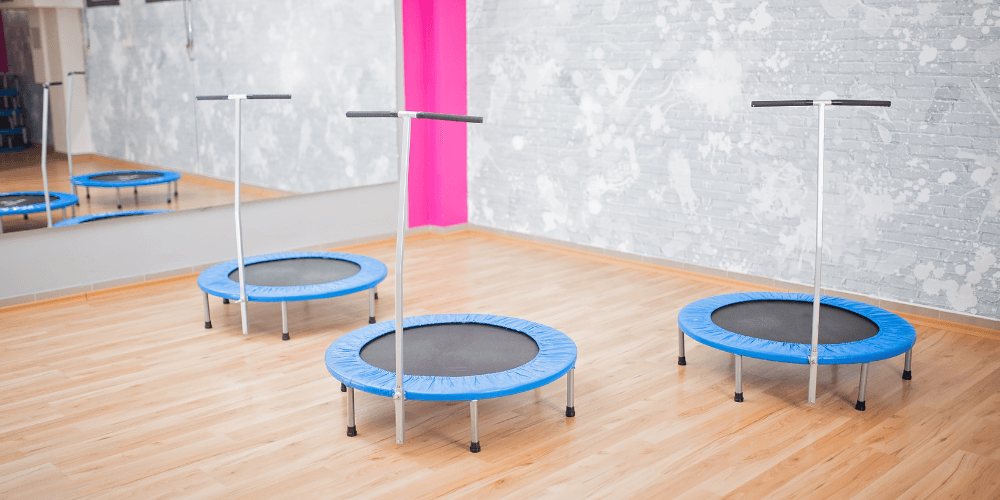Introduction
Picture this:
- The warm breeze on your face
- The feeling of weightlessness
- The pure joy of soaring through the air
That\’s the experience of trampolining. Trampolines aren\’t just for carefree fun; they offer a world of fitness benefits, both physical and mental.In this blog, we\’ll explore trampolines, their daily uses, potential pros and cons, and how they can positively impact your life with real-world examples. So, let\’s jump right in!
What is a Trampoline?
A trampoline is recreational and exercise equipment typically consisting of a strong fabric sheet stretched over a sturdy metal frame using springs. The springy surface gives users incredible bounce, allowing them to perform various flips, jumps, and other acrobatic maneuvers.
Daily Uses of a Trampoline
Trampolines have become multifaceted tools, and here are some ways to use them daily:
- Exercise: Trampolining, or rebounding, is a low-impact workout for all fitness levels and ages, significant for cardio, muscle toning, and balance improvement.
- Fun and Recreation: Trampolines provide a blast of playful energy for children and adults alike, encouraging active fun and a break from screens.
- Therapy: Trampolines are used in physical therapy settings for rehabilitation, sensory integration, and even for individuals with special needs.
- Sports Training: Athletes, particularly gymnasts and divers, incorporate trampolines into their training to hone aerial awareness, coordination, and core strength.
The Pros and Cons of Trampolines
Before you bounce into trampoline ownership, weigh the benefits and potential drawbacks:
Pros
- Fantastic Fitness: Trampolining boosts cardiovascular health, strengthens muscles, burns calories, and improves lymphatic drainage for detoxification.
- Increased Bone Density: The gentle impact of jumping helps build denser bones, minimizing the risk of osteoporosis in adults and promoting healthy bone growth in children.
- Stress Relief and Mood Boost: The act of jumping releases endorphins, the \”feel-good\” hormones, combating stress and elevating your mood.
- Coordination and Balance: Trampoline exercises demand focus and muscle coordination, leading to enhanced motor skills and better balance.
- Accessibility: Trampolines are home-friendly, offering a convenient and enjoyable workout experience regardless of weather or gym availability.
Cons
- Injury Risk: Incorrect use or inadequate safety precautions can result in injuries like head injuries, fractures, or sprains.
- Space Requirements: Trampolines usually need a substantial outdoor area for safe installation and use.
- Maintenance: Regularly checking for wear and tear on the springs, mat, and safety net is essential to keep your trampoline in excellent and safe condition.
- Cost: Quality trampolines can be a significant investment, especially considering additional costs like safety enclosures.
Trampolines and the Real World: Benefits Beyond the Bounce
The benefits of trampolining extend far beyond individual enjoyment and fitness. Let\’s see how:
- Family Bonding: Trampolines encourage quality family time and active play for everyone, promoting laughter and stronger bonds.
- Community Building: Community spaces with trampolines or trampoline parks become hubs of social interaction and physical activity, fostering a sense of togetherness.
- Accessible Exercise: Rebounding\’s low-impact nature makes it a fantastic exercise option for people who may experience joint pain or other limitations when participating in traditional workouts.
- The Olympic Stage: Trampolining is an official competitive sport at the Olympic Games, showcasing incredible athletes who inspire others to push their physical limits.
Types of Trampolines: Your Guide to Finding the Perfect Bounce
Trampolines are remarkably versatile, offering various choices based on size, shape, intended use, and safety features. Whether you\’re seeking a casual backyard trampoline, a fitness tool, or a training apparatus for aspiring gymnasts, there\’s a perfect type out there for you.
Common Types of Trampolines
Round Trampolines
- Features: A round trampoline\’s classic and most popular shape provides a central \”sweet spot\” for even bouncing.
- Best for: Round trampolines are for general recreation, backyard fun, and casual fitness for most ages.
- Considerations: Round trampolines come in various sizes to suit different spaces and needs. Popular brands include Springfree, Vuly, JumpSport, and Skywalker.
Rectangular Trampolines
- Features: Offer a larger surface area and greater bounce height, ideal for skilled jumpers and gymnasts.
- Best for: Rectangular trampolines are best for gymnastics practice, competitive training, and anyone interested in more advanced jumps and tricks.
- Considerations: Require significant space and are often more expensive. Look for brands specializing in gymnastic equipment.
Square Trampolines
- Features: Similar features to rectangular trampolines with a square shape, providing substantial jumping area and high bounce.
- Best for: Square trampolines are best for gymnastics and skilled jumpers, offering an alternative to rectangular trampolines.
- Considerations: They may be less stable than rectangular ones in windy conditions, so secure anchoring is essential.
Mini Trampolines (Rebounders)
- Features: Mini trampolines are small in size, often foldable trampolines designed for indoor use and low-impact workouts.
- Best for: Mini trampolines are often used for fitness, rehabilitation, and improving lymphatic drainage in a small space.
- Considerations: Mini Trampolines are used with limited jump height and are less suitable for outdoor play.
Springless Trampolines
- Features: These use flexible rods instead of traditional metal springs, claiming to offer a safer and smoother bounce.
- Best for: Safety-conscious families with younger children and those concerned about minimizing joint impact during exercise.
- Considerations: They are often more expensive than spring-based options, and the bounce may feel different for those accustomed to traditional trampolines.
Water Trampolines
- Features: Inflatable platforms with a trampoline centre designed for on-water use in lakes or pools.
- Best for: Fun and active play in the water, offering a unique bounce and splash experience.
- Considerations: Water trampolines are primarily used for summer and recreational purposes and are unsuitable for fitness or gymnastics.
Inground Trampolines
- Features: Inground trampolines are installed flush with the ground, eliminating the need for tall safety nets and offering a more aesthetically pleasing design.
- Best for: Homes prioritizing seamless landscaping integration and families seeking a permanent, less visually intrusive trampoline installation.
- Considerations: More expensive due to installation costs and lack of portability of above-ground models.
Choosing the Right Type of Trampoline
Consider the following factors when making your trampoline selection:
- Purpose: Fitness, casual fun, or skill training?
- Space: How much room do you have for a trampoline and its safety enclosure?
- Age of Users: Will children or adults primarily be using it?
- Safety: Prioritize models with solid safety features, particularly if younger children are involved.
- Budget: Trampolines vary in price based on size, features, and quality.
Remember: Always prioritize safety. Supervise children, install safety nets, maintain your trampoline properly, and learn from qualified instructors if attempting advanced skills.
Real-World Examples of the Power of Trampolines
- Rehabilitation Success: A patient who suffered a stroke regains muscle coordination and mobility through a guided trampoline-based therapy program.
- Olympic Dreams: A young gymnast trains diligently on the trampoline, perfecting her aerial skills and eventually qualifying for the Olympics.
- Confidence Boost: A child who struggles with self-confidence discovers the joy of trampolining, mastering new flips, and developing a greater sense of self-belief.
- Stress Management: A busy professional finds a healthy outlet for stress with 15-minute trampoline workouts before or after the workday.
Tips for Safe and Enjoyable Trampolining
Safety is most important when it comes to trampolining. Here\’s how to minimize risks and maximize the fun:
- Supervision: Especially for young children, adult supervision is essential to enforce rules and prevent reckless behaviour.
- One at a Time: To avoid collisions, only allow one jumper on the trampoline simultaneously.
- Safety Enclosures A net enclosure around the trampoline is highly recommended to prevent falls.
- Proper Placement: Place the trampoline on a level, soft surface like grass, away from trees, fences, or other hazards.
- Regular Maintenance: Inspect the trampoline for signs of damage or wear before each use, paying close attention to the springs, mat, and frame.
- Learn Basic Skills First: Start with simple bounces and jumps, mastering control before attempting advanced tricks.
- Avoid Flips (Unless Supervised): Flips and somersaults significantly increase the risk of severe injuries without proper training and supervision.
Choosing the Right Trampoline
With various shapes, sizes, and features available, finding the perfect trampoline for your needs can feel daunting. Consider these factors:
- Size and Shape: Trampolines come in round, oval, square, and rectangular shapes. Round ones are most common for home use, while larger rectangular ones are often used for gymnastics training.
- Weight Capacity: Choose a trampoline with a weight limit that accommodates the heaviest intended user.
- Spring Quality: Durable, high-quality springs ensure a better bounce and longer lifespan for your trampoline.
- Safety Features: Prioritize models with safety padding, sturdy enclosures, and features like springless designs when possible.
- Brand Reputation: Research brands known for making safe, well-constructed trampolines.
Conclusion
Trampolines offer a unique blend of fitness, fun, and therapeutic benefits, bringing joy and improved health to people of all ages. You can unlock a world of mental and physical well-being by following safety guidelines, choosing the right trampoline for your needs, and embracing jumping.
Whether it boosts cardiovascular health, burns calories, builds confidence, or simply brings a smile, the trampoline is a powerful tool in your wellness journey. So, what are you waiting for? Get ready to bounce your way to a happier and healthier you!
Disclaimer
The information in this blog is intended for shared knowledge and does not constitute medical advice. Before starting any new exercise program, it is essential to consult your doctor to ensure it is appropriate and safe for your health conditions. Always use your trampoline responsibly, following all safety guidelines to minimize potential accidents and injuries.


